 |
 |
|
 |
Forester, Metro maintenance crews take on outbreak by felling diseased elm trees |
 |
 |
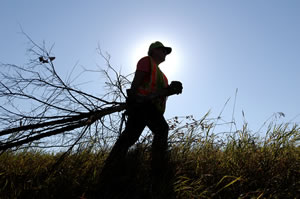 |
|
Silhouetted by the sun, a Metro District tree crew member hauls a diseased branch to the chipper. Photo by David Gonzalez
|
Mn/DOT forester Paul Walvatne calls himself a tree-hugger, but he can wield a chainsaw as well as the next person when the time comes to cut down dead or dying trees.
Good thing.
Walvatne and maintenance workers from the Metro District are working feverishly to identify and destroy diseased trees in state rights-of-way before the latest outbreak of Dutch elm disease can spread further.
The disease decimated the state’s stock of elms in the 1970s. Now, another outbreak threatens the trees, including thousands owned by Mn/DOT.
Walvatne, Environmental Services, said recent climatic conditions such as dry autumns and untimely removal of diseased elms have caused an epidemic of a disease-producing fungus and the elm bark beetles that spread it.
Once a tree is infected, he said, it’s necessary to cut and chip it to prevent elm bark beetles from spreading the fungus to more trees.
Many of the diseased trees, Walvatne said, are on high-visibility corridors such as I-94 and I-35E in St. Paul, along Hwy 5 that carries traffic to the Minneapolis-St. Paul International Airport and on the Gateway Trail that extends from St. Paul to Stillwater.
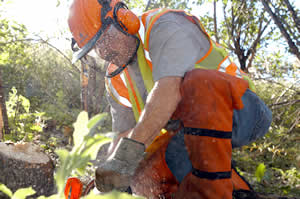 |
Forester Paul Walvatne trims the branches of a diseased elm tree. Photo by David Gonzalez |
Metro’s maintenance workers including Dave Coffey, Phil Pommier, Mike Dochniak, Mark Sanderson and Bernie Schoeberl, all from the Maryland Avenue Truck Station, work with Walvatne to locate diseased trees and take them down. Workers from other stations have also supported the effort.
The tree crew, Walvatne said, ranks trees slated for cutting highest in those cities that have active Dutch elm control programs. That process, he said, combines each city’s efforts with Mn/DOT’s and results in a more effective tree removal program.
Identifying diseased trees and then destroying them is a time-consuming job. The Metro crews, he said, are cutting down about 30 trees a day since their work began in July.
“When the diseased elms are located in a city with an active disease control program,” Walvatne said, “Mn/DOT has the responsibility to quickly identify and remove trees to break the cycle of fungal disease and its transmission by insects.”
By Craig Wilkins
|
back

|
 |
Shortfall projected for next biennium |
 |
 |
After resolving a $4.5 billion budget deficit two years ago, Minnesota continues to face state budget pressures. Current planning estimates show another gap of roughly $400 million to $1 billion.
“Although the economic outlook is on the upswing, the state is currently spending more than we are collecting,” said Lt. Gov./Commissioner Carol Molnau. “The Department of Finance, at the direction of the governor, has requested that all agencies conduct a comprehensive assessment of government operations to improve the quality of priority services, while living within our means.”
Although Mn/DOT receives the bulk of its funding from the Trunk Highway Fund and very little from the General Fund, the Department of Finance has requested that Mn/DOT follow many of the same budget development guidelines and policies as other state agencies.
For this biennium, each agency has been asked to prepare a plan to absorb four percent projected labor and benefit cost increases for each year of the biennium. For Mn/DOT, that figure is $12 million in 2006 and $24 million in 2007.
Agencies must also prioritize spending into a 20-60-20 percent formula. This means that 20 percent of spending would be on the highest priority activities, 60 percent on middle priority activities and 20 percent on the lower priority activities. Agencies must also describe the outcomes and results that will be achieved for spending proposed for each of the activities.
“This administration will not take the approach of ‘everyone feels the pain,’” said Molnau. “Rather, we will determine priority areas and programs for spending. Old and new programs will compete for funding—some will go up and some will go down.”
Molnau added that Mn/DOT is well positioned to work through the budget process. “We are fortunate to have already in place programs like activity based budgeting and systems of targets and measures to help Mn/DOT work better,” she said.
According to Kevin Gray, Finance and Administration Division director, districts and offices have begun addressing the budget issues by reviewing priority areas and programs for spending, and for approaches to absorbing the projected labor costs increases.
As for the “20-60-20 directive,” Gray and other division directors have met with the Department of Finance and division business managers to clarify and review spending priorities and develop shared guidelines based on the agency’s strategic plan.
The deadline for submitting the information and budget request to the Department of Finance is Oct. 1.
The State of Minnesota operates on a two-year budget cycle referred to as the biennium. State fiscal years begin on July 1 and end the following June 30. More information, including budget policy guidance, can be found at http://www.budget.state.mn.us//budget/index.shtml .
By Jeanne Aamodt
|
back

|
 |
Governor’s plan allows Northstar commuter rail line to move forward |
 |
 |
Gov. Tim Pawlenty gave new life to the Northstar commuter rail project recently with a $22.5 million breath of funding.
The funding is $2.5 million in Metropolitan Council money that will allow the project to acquire $10 million in federal matching funds. The Northstar Corridor Development Agency, the office managing the project, will also contribute an additional $10 million.
The money will be used to acquire land along the corridor and to continue work with the Burlington Northern Santa Fe Railroad, which owns the line the commuter rail will run on.
The project, whose estimated cost is about $265 million, still requires additional funding from the state Legislature.
The Northstar line is 40 miles long and will run from Big Lake to downtown Minneapolis. It would relieve congestion along both the Hwy 10 and Interstate 94 corridors that run from the northwestern part of the metro area.
Commuter rail is a service that uses existing rail lines. The rail cars are heavier than those used by the Hiawatha Light Rail line.
Click here to read the governor’s news release on funding the Northstar corridor. For more information about the project, go to the Northstar commuter rail Web site.
By Kevin Gutknecht
|
back

|
 |
Eighteen rail-related fatalities this year prompt urgent safety warning
|
 |
 |
Spurred by 18 rail-related deaths this year, including four during the first 10 days of August, Mn/DOT joined the Department of Public Safety and Operation Lifesaver to urge that drivers and pedestrians use extra caution when approaching a railroad-grade crossing or entering railroad property.
Of the 18 deaths, nine occurred at highway rail crossings. Another nine people died when they were hit by trains while trespassing on railroad rights-of-way or other property.
Crashes involving motor vehicles and trains bring the total number of rail-crossing fatalities this year to nine, one more than reported for all of last year.
The latest pedestrian fatality brings the number of deaths this year to nine. There were eight such fatalities in 2003.
Three people died in three separate vehicle collisions this month with trains near Rosemount, Odin (Watonwan County) and Mankato. Another August fatality occurred when a pedestrian was struck by a train in Sauk Rapids.
“If the current trend continues, 2004 will become one of the most deadly years for motorists and pedestrians at rail crossings in recent history,” said Al Vogel, director of Freight, Railroads and Waterways.
The Minnesota Safety Council coordinates the work of Minnesota’s Operation Lifesaver, a joint effort by Mn/DOT, Public Safety, other law enforcement agencies and the railroads to promote rail safety awareness.
Rail-crossing crashes are often attributed to motorists’ being in a hurry or distracted, said Kathy Swanson, traffic safety director with DPS.
“It’s a lot better to slow down and focus on the task at hand and be late than to not get there at all,” she said.
More safety information is available from the national Operation Lifesaver Web site, www.oli.org.
By Craig Wilkins
|
back

|
 |
Mobile lab provides in-the-field technology transfer on advanced asphalt pavement design, performance |
 |
 |
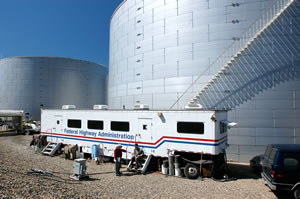 |
|
Located near the Wakota Bridge project in Newport, the Federal Highway Administration’s mobile asphalt lab sits in a prime location to support Mn/DOT’s use of high-performance bituminous pavement on the project and elsewhere. Photo by David Gonzalez |
Surrounded by the massive Wakota Bridge project in Newport, the FHWA’s mobile asphalt lab sits in a prime location to support Mn/DOT’s use of high-performance bituminous pavement on the project and elsewhere.
The lab’s crew is learning—and measuring—a lot as well.
During its five-week stay in Minnesota, The lab’s crew measures how Mn/DOT uses the most-advanced asphalt pavements. Their work provides valuable feedback to department pavement designers while adding to the FHWA’s growing store of knowledge about bituminous pavement performance in the field.
Based in Washington, D. C., the lab crew will eventually take its work on asphalt pavement design to all 50 states. The current project started about one year ago, said Jagan Gudimettla, the mobile lab’s project engineer.
For the past month, staff from the Office of Materials and Research and the lab’s crew have been testing the asphalt mixes used to build bituminous pavement generally known as “Superpave.”
“The mobile lab gives us the capability to do tests that we normally can’t do,” said Dan Boerner, bituminous engineer, Materials and Road Research.
Tests include those that can predict pavement performance in the field and an imaging system that determines several characteristics of aggregate materials.
“When choosing aggregates we tend to go by size, like building a basketball team,” Boerner said. “However, with the mobile lab’s imaging system, we can predict an aggregate’s performance based on combined factors such as surface roughness, sphericity, strength, and texture.”
The lab’s other specialized equipment, he said, also predicts a specific pavement design’s resistance to rutting.
That equipment includes a gyratory compactor replicates construction equipment and traffic effects, consolidates bituminous mixes in the field, and provides designers with data to avoid future problems.
The compactor, Boerner said, uses a gyratory motion to compact specimens rather striking them with devices known as Marshall hammers.
The gyratory motion reflects the dynamic forces that affect pavement more accurately than other methods, he said, leading to more reliable test results.
The data collected from Mn/DOT’s I-494 project and other highway projects will widen the FHWA lab staff’s knowledge of pavement design that they will share with other states during its current round of visits.
Lab staff will also help analyze results a bituminous mix installed at the Minnesota Road Research facility on I-94 near Monticello. The mix uses a high percentage of Mesaba hard rock for aggregate, a byproduct of taconite production in northern Minnesota.
Before coming to Minnesota, the lab crew worked with the Kansas DOT. Next stop, Gudimettla said, is upstate New York. Wherever the lab goes, its staff and expertise will be available to Mn/DOT and other state DOTs.
“The FHWA has broad experience and a track record developing the Superpave design method,” Boerner said. “We hope their work will give us the performance testing we’ve been looking for.”
By Craig Wilkins
|
back

|
 |
Cable median barrier projects aim to reduce crashes, save lives |
 |
 |
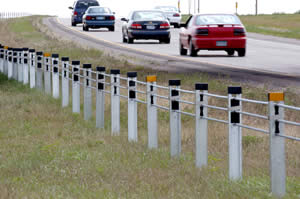 |
|
A mile of the cable median barrier from I-94/694 and I-494 split (Fish Lake Interchange) to the I-94 rest area near Rice Lake in Maple Grove was finished late this spring. Photo by David Gonzalez |
Numerous cross-median crashes along Interstate 94 in the northwest Twin Cities Metro area and Brainerd/District 3 have prompted Mn/DOT to install an innovative high-tension three-cable median barrier in several locations this year.
Last year, a four-cable high-tension median barrier was installed on Hwy 23 just east of Cold Spring, near St. Cloud.
The three-cable barriers guide errant vehicles back toward their original lanes by reduced deflection. Their average deflection is about five feet compared with 11 feet for standard barriers.
The three-cable barriers are carried on steel posts that slide into a steel sleeve. If damaged, the post slides out easily to allow a new one to be installed.
The first project to install nearly a mile of the cable median barrier from the I-94/694 and I-494 split (Fish Lake Interchange) to the I-94 rest area near Rice Lake in Maple Grove was finished late this spring. An additional seven miles of the cable is currently being worked on from the Rice Lake Rest Area to the Crow River, just south of Rogers.
By October, nearly eight miles of the barrier will be installed within the median of I-94 from I-94/694 and I-494 junction to the Crow River south of Rogers and at interchanges in Albertville and St. Michael in District 3.
The cable median barrier is funded by federal safety funds Mn/DOT received late last year for safety improvements within the I-94 corridor.
Crossover crashes are rare but usually result in serious injuries or fatalities. The state records an average of 15 fatal cross-median crashes each year on four-lane divided highways, according to crash statistics compiled by the Department of Public Safety.
By Kent Barnard, Metro District public affairs coordinator
|
back

|
 |
Information technology classification study appeals due Sept. 1 |
 |
 |
Sept. 1 marks the new deadline for information technology study participants to appeal decisions made regarding classification changes to the Office of Human Resources. The Department of Employee Relations granted the extension due to data practices requests sparked by the IT study results.
Mn/DOT conducted the six-month study earlier this year to confirm the current classification level of information technology specialist positions at or above the ITS 3 level as well as supervisory IT classes.
Out of the 147 positions reviewed, most employees demonstrated that they did 70 percent IT-related work and remained in the IT classification; however, nearly half of them were reclassified into a lower level IT position. (This statement is a clarification from the July 14 issue of Mn/DOT Newsline.)
Participants who choose to appeal the decision must contact the Office of Human Resources in writing and must include information not previously presented in order for the decision to be reconsidered.
For previous coverage on the IT study, see the July 14 issue of Mn/DOT Newsline. Readers may also visit the IT study Web page and click on “Frequently Asked Questions” at http://ihub.hrapps.dot.state.mn.us/itStudyFaq.html .
By Daneeka Marshall-Oquendo
|
back

|
 |
Duluth’s Tom Jacobson receives award for innovative roadside vegetation practices |
 |
 |
 |
|
Tom Jacobson, Duluth/District 1, at work managing roadside vegetation. |
Tom Jacobson’s expertise and passion for environmentally friendly ways to manage roadside vegetation earned recognition from Minnesota’s Integrated Pest Management Working Group.
Officials from the state departments of Natural Resources and Agriculture co-chair the working group.
The award was presented July 27 during the annual meeting of the state’s Association of Country Agricultural Inspectors.
It honors Jacobson’s “outstanding efforts and innovative programs in local areas” to meet requirements of the state’s Groundwater Protection Act of 1989.
Jacobson is a senior transportation generalist and landscape specialist with Duluth/District 1. He joined Mn/DOT in1985 at the International Falls Truck Station.
Self-motivated and largely self-taught, Jacobson gained his knowledge in the field and by collaborating with environmentalists from Mn/DOT and other agencies. His efforts created a roadside management plan for the district and earned the respect of his peers in managing roadside environments.
Jacobson plans and coordinates vegetation management in the Duluth Maintenance Area that includes hundreds of miles of state highways, 20,000 acres of roadsides and several first class rest areas.
The plan calls for the judicious use of chemicals, native plants and biological control of leafy spurge and other invasive, non-native plants to keep trees, plants and the roadside ecosystems healthy.
Biological control methods he has introduced include using insects that feed on leafy spurge, spotted knapweed and other invasive plants instead of spraying them with chemicals. Jacobson worked with Tina Markeson, a forester with Environmental Services, and Pamela Deerwood of the U. S. Department of Agriculture to develop the district’s bio-control plan.
He also plans to involve the logging industry to thin pine plantations along I-35 between Hinckley and Moose Lake and other locations. Having loggers thin the plantings would remove excess trees at minimal cost and create a productive use for them.
Jacobson’s goals for the program include a roadside environment where “there is minimal use of herbicides, no hazard trees and each ecosystem is self-sustaining.”
|
back

|
 |
Mn/DOT goes to the State Fair |
 |
 |
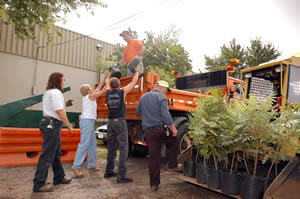 |
|
Metro District staff unload landscaping that will help transform the plot at 1698 Judson Blvd. into Mn/DOT's exhibit at the annual Minnesota State Fair. Photo by David Gonzalez |
The wait for your favorite food on a stick is over; the Great Minnesota Get Together starts tomorrow. Amid the corn dogs, butter carving, pie judging, grandstand acts and carnival rides, fairgoers will find the Mn/DOT booth.
This year’s exhibit focuses on safety and updates to the state’s 511 traveler information system. Displays at the booth include information about safe travel in highway work zones and safety tips for walking, biking or driving along or across state roads or railroad tracks. A Freeway Incident Response Safety Team truck and snowplow will be available for visitors to check out.
Nearly 100 Mn/DOT employees will help staff the exhibit during the 12 days of the fair, and speakers will be on hand to share information about pedestrian safety with children and elders on Aug. 26, 30 and 31 and on Sept. 2.
Visitors will also have an opportunity to speak with Lt. Gov/Commissioner Carol Molnau, who will help staff the exhibit several times during the event.
The exhibit is located on Judson Avenue and Underwood Street, west of the Empire Commons Building. The Aeronautics exhibit, with its display of unique aircraft such as the Avro Avian, a 1930s aircraft similar to that flown by Amelia Earhart, is located just north of the Como Ave. entrance next to the greenhouses.
For more information, including a map of the fairgrounds and the commissioner’s schedule, check out the Mn/DOT at the Fair Web site at www.dot.state.mn.us/fair.
By Kay Korsgaard
|
back

|
 |
|
 |



